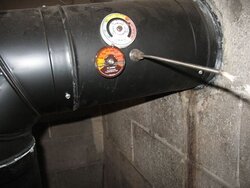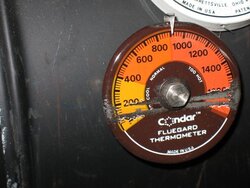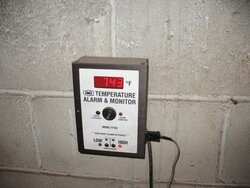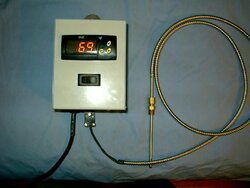Ok, here is the results everyone has been waiting for.
Pen sent me on of his Condar probe type thermometers.
This model is basically a by-metal spring type thermometer (like the magnetic ones that you would put on the stove top), with a metal rod that protrudes in to the flue.
One thing, the probe Pen sent me was the one that arrived to him damaged. Pen unbent the dial face but the pointer looks like it may be slightly bent. The pointer seems to be a bit toward the cooler side, so a undamaged one may possibly be less accurate than this one.
I installed the Condar right next to the thermocouple on the single wall pipe of my Fisher stove. I tried to have the temp stable on the controller to allow for the slower response of the Condar when I recorded my readings.
What I found was the Condar was reading 100 °F to 200 °F higher than the thermocouple.
Her are some readings:
Thermo Condar
600 700
650 800
750 900
800 1000
The Condar is more accurate at lower temp and gets less accurate as temp increases.
All in all, I would say for the price it's probably good enough to give a reasonable approximation of flue temp, but certainly not a substitute for a thermocouple type probe.
Pen sent me on of his Condar probe type thermometers.
This model is basically a by-metal spring type thermometer (like the magnetic ones that you would put on the stove top), with a metal rod that protrudes in to the flue.
One thing, the probe Pen sent me was the one that arrived to him damaged. Pen unbent the dial face but the pointer looks like it may be slightly bent. The pointer seems to be a bit toward the cooler side, so a undamaged one may possibly be less accurate than this one.
I installed the Condar right next to the thermocouple on the single wall pipe of my Fisher stove. I tried to have the temp stable on the controller to allow for the slower response of the Condar when I recorded my readings.
What I found was the Condar was reading 100 °F to 200 °F higher than the thermocouple.
Her are some readings:
Thermo Condar
600 700
650 800
750 900
800 1000
The Condar is more accurate at lower temp and gets less accurate as temp increases.
All in all, I would say for the price it's probably good enough to give a reasonable approximation of flue temp, but certainly not a substitute for a thermocouple type probe.





